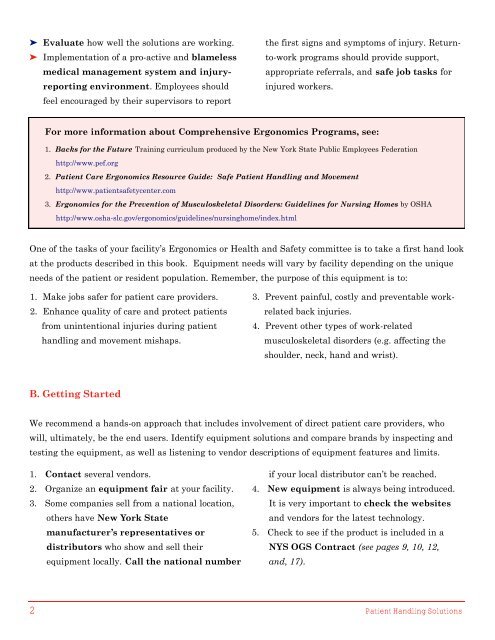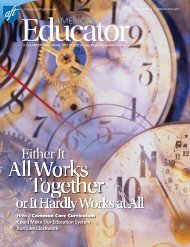Patient Handling Solutions - American Federation of Teachers
Patient Handling Solutions - American Federation of Teachers
Patient Handling Solutions - American Federation of Teachers
You also want an ePaper? Increase the reach of your titles
YUMPU automatically turns print PDFs into web optimized ePapers that Google loves.
➤ Evaluate how well the solutions are working.<br />
➤ Implementation <strong>of</strong> a pro-active and blameless<br />
medical management system and injury-<br />
reporting environment. Employees should<br />
feel encouraged by their supervisors to report<br />
For more information about Comprehensive Ergonomics Programs, see:<br />
1. Backs for the Future Training curriculum produced by the New York State Public Employees <strong>Federation</strong><br />
http://www.pef.org<br />
2. <strong>Patient</strong> Care Ergonomics Resource Guide: Safe <strong>Patient</strong> <strong>Handling</strong> and Movement<br />
http://www.patientsafetycenter.com<br />
3. Ergonomics for the Prevention <strong>of</strong> Musculoskeletal Disorders: Guidelines for Nursing Homes by OSHA<br />
http://www.osha-slc.gov/ergonomics/guidelines/nursinghome/index.html<br />
One <strong>of</strong> the tasks <strong>of</strong> your facility’s Ergonomics or Health and Safety committee is to take a first hand look<br />
at the products described in this book. Equipment needs will vary by facility depending on the unique<br />
needs <strong>of</strong> the patient or resident population. Remember, the purpose <strong>of</strong> this equipment is to:<br />
1. Make jobs safer for patient care providers.<br />
2. Enhance quality <strong>of</strong> care and protect patients<br />
from unintentional injuries during patient<br />
handling and movement mishaps.<br />
B. Getting Started<br />
the first signs and symptoms <strong>of</strong> injury. Return-<br />
to-work programs should provide support,<br />
appropriate referrals, and safe job tasks for<br />
injured workers.<br />
We recommend a hands-on approach that includes involvement <strong>of</strong> direct patient care providers, who<br />
will, ultimately, be the end users. Identify equipment solutions and compare brands by inspecting and<br />
testing the equipment, as well as listening to vendor descriptions <strong>of</strong> equipment features and limits.<br />
1. Contact several vendors.<br />
2. Organize an equipment fair at your facility.<br />
3. Some companies sell from a national location,<br />
others have New York State<br />
manufacturer’s representatives or<br />
distributors who show and sell their<br />
equipment locally. Call the national number<br />
3. Prevent painful, costly and preventable work-<br />
related back injuries.<br />
4. Prevent other types <strong>of</strong> work-related<br />
musculoskeletal disorders (e.g. affecting the<br />
shoulder, neck, hand and wrist).<br />
if your local distributor can’t be reached.<br />
4. New equipment is always being introduced.<br />
It is very important to check the websites<br />
and vendors for the latest technology.<br />
5. Check to see if the product is included in a<br />
NYS OGS Contract (see pages 9, 10, 12,<br />
and, 17).<br />
2 <strong>Patient</strong> <strong>Handling</strong> <strong>Solutions</strong>





